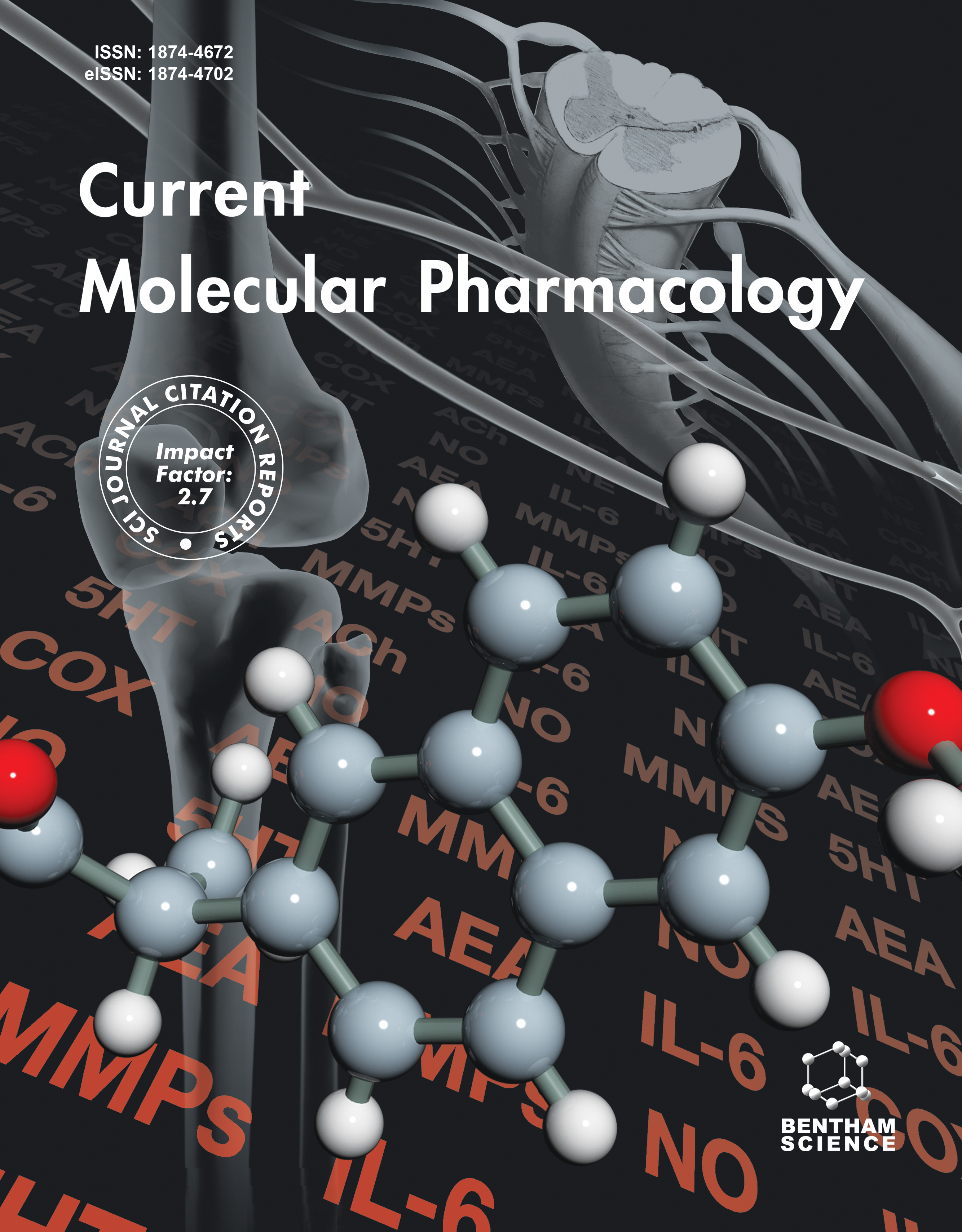- Home
- A-Z Publications
- Current Molecular Pharmacology
- Previous Issues
- Volume 11, Issue 2, 2018
Current Molecular Pharmacology - Volume 11, Issue 2, 2018
Volume 11, Issue 2, 2018
-
-
MicroRNAs, Cancer and Diet: Facts and New Exciting Perspectives
More LessAuthors: Maria L. Motti, Stefania D'Angelo and Rosaria MeccarielloBackground: MicroRNAs (miRNAs) are small non-coding RNAs able to regulate gene expression at multiple levels. They are detected in tissues, blood, and other body fluids with high stability and have a recognized role in maintaining of tissue homeostasis. Aberrant expression profile of miRNAs has been observed in several diseases, primarily cancer. As a consequence, the analysis of miRNA signature has recognized dia Read More
-
-
-
Opioids in the Frame of New Psychoactive Substances Network: A Complex Pharmacological and Toxicological Issue
More LessAuthors: Ludovic Ventura, Felix Carvalho and Ricardo J. Dinis-OliveiraBackground: New psychoactive substances (NPS), often referred to as “legal highs” or “designer drugs”, are derivatives and analogues of existing psychoactive drugs that are introduced in the recreational market to circumvent existing legislation on drugs of abuse. Objective: This systematic review aims to gather the state of the art regarding chemical, molecular pharmacology and toxicological information of opioid class of Read More
-
-
-
Prooxidant-Antioxidant Balance and Antioxidant Properties of Thuja orientalis L: A Potential Therapeutic Approach for Diabetes Mellitus
More LessBackground: Diabetes mellitus (DM) is a major health problem with an increasing global prevalence. It is usually associated with an imbalance between pro-oxidant mechanisms and antioxidant defenses, contributing to oxidative-stress, and this leads to an increased susceptibility to endothelial dysfunction, atherosclerosis, insulin-resistance and impaired-pancreatic β-cell function. Objective: We have assessed the Pro Read More
-
-
-
Characterization of Imatinib Resistant CML Leukemic Stem/Initiating Cells and Their Sensitivity to CBP/Catenin Antagonists
More LessAuthors: Yi Zhao, Kaijin Wu, Yongfeng Wu, Elizabeth Melendez, Goar Smbatyan, David Massiello and Michael KahnBackground and Objective: The development of the tyrosine kinase inhibitor Imatinib (IM) represents a milestone in CML (Chronic Myeloid Leukemia) treatment. However, it is not curative and patients develop IM resistance. IM resistance has been previously correlated with the emergence of drug-resistant LIC/LSC (Leukemia Initiating Cell/Leukemia Stem Cell) and increased nuclear catenin levels and enhanced Read More
-
-
-
MG17, A Novel Triazole Derivative Abrogated Neuroinflammation and Related Neurodegenerative Symptoms in Rodents
More LessAuthors: Gangadhar Matharasala, Ganesh Samala and Yogeeswari PerumalBackground and Objective: The objective of present study is to explore multiple effects of the compound MG17 and relate them to achieve better therapeutic potential against neuroinflammation related disorders. We examined whether our compound is acting through regulating neuroinflammatory mediators. Methods: We have done some preliminary behavioral studies to shortlist the derivatives using rodent mo Read More
-
-
-
Umbelliferone Decreases Intracellular pH and Sensitizes Melanoma Cell Line A375 to Dacarbazin. Comparison with Acetazolamide
More LessBackground and Objective: The high degree of malignancy of tumour cells is linked to alterations of many physiological parameters like the intracellular pH (pHi). The pHi in cancer cell line is regulated by the carbonic anhydrase IX (CA IX). The main enzymatic function of the CA IX protein is to catalyze the hydration of carbon dioxide into bicarbonate ions and protons. CA IX expression in a broad variety of human tumor tiss Read More
-
-
-
Molecular Insights of CREB and MAP-K Phosphorylation by Modafinil in Wake-Related Brain Areas
More LessBackground: Modafinil (MOD) is a waking-promoting compound that is used for the treatment of sleep disorders such as sleepiness and narcolepsy. Despite its efficiency, there are missing pieces of evidence regarding the mechanism of action of MOD at molecular level. For example, current data have demonstrated that MOD induces alertness by activating several wake-related neurotransmitter receptors, including dopamine Read More
-
-
-
The Non-Genomic Effects of the PPARβγ Agonist GW0742 on Streptozotocin Treated Rat Aorta
More LessAuthors: Noelia Perez-Diaz, Igor Pushkarsky, Nadia Oweis, Lisa A. Lione and Louise S. MackenzieBackground: The ubiquitous nuclear receptor PPARβ/δ is increasingly being studied in regards to numerous diseases including diabetes following on the finding that PPARβ/δ agonist GW0742 controls Type 1 Diabetes in rats. Studies have shown that GW0742 has off target, non- PPARβ/δ effects in the cell although there are some key questions that remain to be addressed in respect to the significance of this control on vascular ton Read More
-
-
-
The Nephroprotective Effect of N-Acetyl-L-Cysteine and Atorvastatin against Imipenem induced Nephrotoxicity
More LessBackground and Objective: Imipenem has played an important role in the treatment of broad-spectrum bacterial infection. However, nephrotoxicity due to imipenem remains an important clinical challenge. The aim of this study is to test the hypothesis stating that N-acetyl-L-cysteine (NAC) and atorvastatin possess a nephroprotective effect against imipenem-induced nephrotoxicity. Methods: Adult Sprague Dawley rats were rand Read More
-
-
-
Gamma-Decanolactone Improves Biochemical Parameters Associated with Pilocarpine-Induced Seizures in Male Mice
More LessBackground and Objective: Gamma-decanolactone (GD) is a monoterpene effective against seizures induced by pentylenetetrazole. The mechanism of action of GD is likely to be via glutamate antagonism. GD also inhibits intracellular reactive oxygen species (ROS) generation and the lipopolysaccharide-induced expression of inducible nitric oxide synthase (iNOS) and tumor necrosis factor-alpha (TNF-α) in vitro. Conside Read More
-
Most Read This Month
Article
content/journals/cmp
Journal
10
5
false
en


